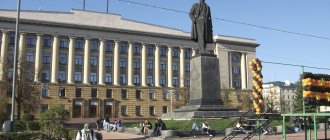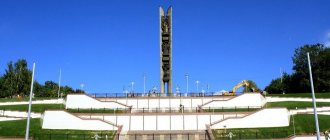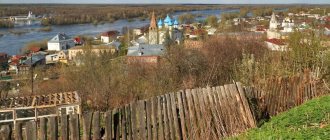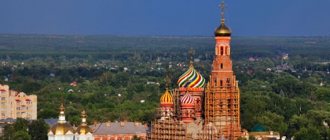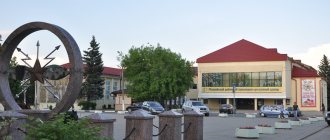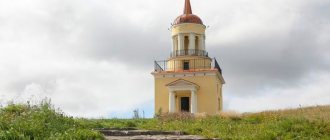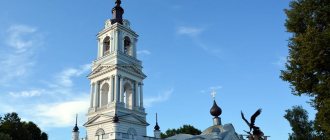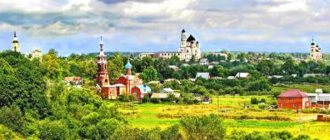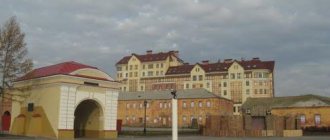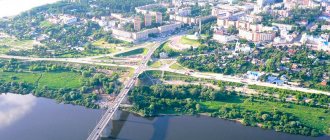The small town of Diveevo, in the Nizhny Novgorod region, is known throughout the country as a major spiritual center of Russian Orthodoxy, as well as a place with a rich history and unique attractions. Its popularity is mainly associated with the Holy Trinity Seraphim-Diveevo convent located here, which is visited annually by thousands of pilgrims from all over the country. The settlement of Diveevo arose in 1559 on the banks of the Vichkenza River. It was founded by the Tatar Murza Divey, who received the right to rule over these lands from Ivan the Terrible himself. The settlement was named after its founder. A special feature of Diveevo was that the village was located at the intersection of several pilgrimage routes and provided shelter for travelers tired from the road. Soon, a temple dedicated to St. Nicholas was erected on the territory of the village, which was the main temple of the settlement until the 18th century. At the end of the 18th century, a convent was founded here. In honor of St. Seraphim of Sarov, who took care of the nuns, the monastery was named after him. Despite the difficult trials that befell the monastery during the Soviet era, today the Diveyevo monastery is an important spiritual center and annually receives thousands of believers from different parts of Russia and abroad.
Sights of Diveevo with descriptions and photos
Holy Trinity Seraphim-Diveevo Convent
Holy Trinity Seraphim-Diveevo Convent
The Diveevo monastery is considered the fourth destiny on Earth, patronized by the Mother of God herself. The monastery has a rich and interesting history. As the legend says, in 1767, pilgrim Agafya Melgunova stopped in Diveevo on her way to the Sarov Monastery. Here the Mother of God appeared to her in a dream and ordered to build a convent in Diveevo. Already in 1772, a temple was erected in the village in honor of the Kazan Icon of the Mother of God and a women's religious community was founded. In 1788, the temple was given a land plot for the construction of cells. The monastery actively developed and expanded over the course of 150 years. In 1825, the Monk Seraphim of Sarov took custody of the nuns, who by that time had completed his 55-year retreat. Here he received everyone who needed his spiritual guidance. As the legend says, one day the Mother of God appeared to the monk in a dream, who, having walked around the monastery, ordered to surround it with a rampart and dig a ditch around it. This was supposed to forever protect the holy place from devilish manifestations and other troubles. The nuns dug the ditch for about four years. Seeing the work done, the Monk Seraphim of Sarov said to the nuns: “Here you have Athos, Jerusalem, and Kyiv.” There is a belief that the Mother of God will definitely hear the prayer of the one who walks along the groove and reads the prayer to the Mother of God 150 times. During the Soviet era, the monastery experienced difficult times. The temples were closed, the earthen rampart was razed, and the holy ditch was almost completely filled up. The monastery premises housed a labor artel and warehouses. Later, this place was completely closed, and the monastery began to slowly decline. However, in the 80s of the last century, the monastery began to be slowly restored. The temples were returned to the churches and restored, the holy ditch, which had fallen into disrepair, was again dug and equipped. In 2012, construction began on a new temple - the Annunciation, which was conceived by Seraphim of Sarov. The saint even indicated the place where it should be placed. Today, the Seraphim-Diveevo Monastery is considered one of the main pilgrimage centers of the Russian Federation, annually receiving thousands of believers from all over the world.
Temples of Diveevo
Holy Trinity Cathedral
Holy Trinity Cathedral
This place is the main temple of the Seraphim-Diveevsky Monastery. The relics of Saint Seraphim of Sarov and many venerable Sarov elders are kept here. According to legend, the Mother of God herself indicated the site for the construction of the cathedral to Seraphim of Sarov. The monk bought the indicated plot of land with his own funds, and ordered the deed of sale for the land to be kept in the monastery until the time suitable for the construction of the temple. The foundation stone for the temple was laid in 1865, and its construction lasted 10 years. Initially, the cathedral was supposed to become a place for summer services. The interior of the cathedral is unique - all the paintings inside the temple were made not on the walls, but on large canvases. The main icon of the cathedral and one of the most important relics of the Diveyevo monastery is the “Tenderness” icon of the Mother of God, transported here from the Sarov desert after the death of Seraphim of Sarov, who prayed all his life in front of this miraculous image.
Kazan Church of the Mother of God
Kazan Church of the Mother of God
The Kazan Church is the oldest on the territory of the Diveyevo Monastery. It was with its construction that the history of the local female monastic community began. The Kazan Church was consecrated in 1780. At that time it had two chapels dedicated to St. Nicholas and Archdeacon Stephen. The women's Orthodox community under the leadership of Mother Alexandra was ruled by the elders of the Sarov Hermitage. According to Seraphim of Sarov, the Kazan Church is one of three, “which from all over the world will be taken entirely undestroyed to heaven.”
Transfiguration Cathedral
Another temple, part of the complex of buildings of the Diveyevo Monastery, which Seraphim of Sarov bequeathed to be built. It is located at the end of the Holy Canal, next to the Trinity Cathedral. At the place indicated by the monk, a small Tikhvin church made of wood was erected, which later burned down in a fire. The cathedral was founded on the side of the Holy Canal in 1907. Built in neo-Russian style, it attracts the attention of monastery guests with the lightness of its architectural forms. During the Soviet era, the temple premises were used as a garage and quickly fell into disrepair. Trees grew on the roof of the temple, almost collapsing it. However, the temple survived and was completely restored. Today it houses the holy relics of St. Martha of Diveyevo and Blessed Pasha of Sarov.
Diveevo - Russia
Good day everyone!
Thank God, I visited Diveevo “self-propelled” for two days, October 8-9, 2016. And based on the results of the trip, I want to update the information about transport links between Diveevo and Arzamas, because... When preparing for the trip, I was unable to find fresh and reliable information about this - either the information was many years old, or the date of publication was completely unclear. That's why I'm writing this update - maybe it will be useful to someone and help in some way.
So, here is the information I have about transport between Diveevo and Arzamas as of 10/08/2016.
1. The road from the Arzamas-2 railway station to Diveevo.
Most trains from Moscow arrive at the Arzamas-2 railway station. There are many mentions on the Internet that directly from this railway station you can take a regular bus to Diveevo - unfortunately, this is NOT the case now: it was like that before, but now a new bus station has opened in Arzamas (Nizhny Novgorod region, Arzamas, Lenin street , 21A), and the buses going from it to Diveevo do NOT pass through the Arzamas-2 railway station (I’m not sure about the Arzamas-1 railway station, but I think that they don’t go through it either, because they are both are “not on the way” from this bus station to Diveevo, but rather to the side).
You can’t just walk from the Arzamas-2 railway station to the bus station - it’s very far, so you either have to take a local taxi to the bus station (taxi drivers always meet trains there, especially Moscow ones, there’s always someone there, but I don’t know the price of such a trip) , or, according to a local resident, you can get to it by city buses No. 1 (preferable) or No. 4 passing there (there are no other buses there, only these two). According to her, it is better to take bus No. 1 - the journey on it will take “15 minutes” (in her words), and No. 4 makes a detour, and therefore the ride on it will take “about half an hour” (in her words).
At the same time, you must keep in mind that this bus station is not the final stop of these buses, and they do not call at the bus station itself, so you also need to know which stop to get off at, and then walk a little bit to the bus station itself. I myself could not clarify and verify this information (I used another method, see below), and in the end I never got to the bus station, so I couldn’t check the relevance of the schedules of regular buses from Arzamas to Diveevo and back provided on the Internet and the price of tickets for them. smog. Although someone told me that a ticket for a regular bus to Diveevo would cost 200 rubles (I didn’t check).
There are two other ways to go directly from Arzamas-2 to Diveevo: take a private taxi or take a private gazelle minibus. In this case, the journey will take approximately 1 hour. About the taxi, I can only say that in my presence (i.e. at approximately 06:50 on the morning of Saturday, October 8, 2016) the taxi driver undertook to take 3 women to Diveevo for 200 rubles each (i.e. 600 rubles all car). For the rest, read advice on the Internet, and firmly and in advance agree on the price of the trip, so that in the middle or at the end it does not “unexpectedly” change for some reason not in your favor.
I used the last option: along with the taxi drivers, there was another man walking there and inviting people into a private gazelle minibus at a price of 300 rubles per person. Because The gazelle was already almost full, and he wanted to send it quickly (of course, it only left when there were no empty seats left), then we agreed on 250 rubles. He gave all the passengers their business cards and said that they could organize a meeting at any station in Arzamas, as well as a late departure from Diveevo, at approximately 20:30 (at this time regular buses have not been running for a long time, and even the monastery PAZik has long left ), you just need to call them no later than 13:00 on the day of departure from Diveevo, preferably the night before. Just in case, I’m giving their contacts from this business card (don’t take it as advertising - I’m just giving it for information) in case someone finds it useful: +7-905-011-888-3, Igor. They also organize excursions to Holy Places. The journey on this gazelle took almost 1 hour; in Diveevo the gazelle stopped next to one of the entrances to the monastery territory.
2. The road from Diveevo to the Arzamas-2 railway station.
The bus station in Diveevo is located next to the monastery, about 500 m from it. There is a lot of information on the Internet about bus schedules through it, but I did not check it because... I decided in advance that I would go back on the monastery bus (PAZik), which leaves for Arzamas daily at 19:00 from the Pilgrimage Center on the territory of the monastery. Usually it goes to the Arzamas-2 railway station, but if someone needs to go to Arzamas-1, then you need to warn the driver and the monastery guard accompanying the bus about this (!), and they will certainly meet you halfway. The road to Arzamas-2 takes approximately 1 hour. This monastery PAZik is the latest “regular” bus from Diveevo: the last regular buses leave Diveevo at 16-17 hours. And although the evening services do not have time to end by this time (by 19:00), it still gives the opportunity to stay in Diveevo a little longer, which is very pleasant. A ticket for it must be bought at the Pilgrimage Center of the monastery, it costs 130 rubles. However, you must keep in mind that the number of seats in it is limited to the seats of the PAZik, standing in it is not allowed, so I highly recommend buying tickets for it as far in advance as you can - I took them immediately upon arrival at the monastery, on Saturday morning (at about 08:00). :30 on Saturday morning) on Sunday evening, and I was not the first at all, I got seat number 10 (tickets with seats; upon boarding, tickets are checked and a roll call of passengers is carried out so as not to forget anyone).
3. A quick note about nutrition.
I would also like to note that in the monastery itself there is a free pilgrimage refectory, where after the morning (late) Liturgy you can have a good lunch, and after the evening service you can have dinner: in the “summer” time (my visit on October 08-09, apparently, fell on “ summer" time) lunch was from 11:30 to 13 or 14 o'clock (I don't remember exactly), and dinner in the evening was until 22:00 (I don't remember the start of dinner).
This dinner is especially valuable: as far as I understand, all or almost all cafes in the city are already closed at this time, and even stores like Pyaterochka and Magnit are only open until 21 o'clock, so after 20-21 o'clock there is enough food in the city problematic, and you need to take care of your dinner in advance, in the afternoon.
Holy springs
Source of Seraphim of Sarov
Spring of Seraphim of Sarov
Built on the Satis River, the holy spring of Seraphim of Sarov in Diveevo is most popular among believers visiting the monastery. Initially, the source belonged to the Sarov Desert, but in recent years it has increasingly been attributed to the Diveyevo Monastery. The history of the emergence of this healing spring is remarkable. This event occurred in the 60s of the last century. According to legend, an old man in a white robe appeared in front of a soldier who was on guard duty at the border of a guarded perimeter in the forest. The soldier asked him: “What are you doing here?” Instead of answering, the elder struck the ground with his staff, and a clear spring began to flow in that place. Having learned about this story, local authorities ordered the spring to be filled up. However, the equipment that was fitted for this constantly stalled and refused to work. An old man in white robes appeared to the tractor driver who was supposed to fill up the spring and asked him not to do this. After this, the tractor driver flatly refused to fill up the source, and he was left alone.
Today, the Seraphim Spring has been equipped and ennobled, and all visitors to the Diveyevo Monastery come to it for healing water.
Mother Alexandra's Source
This healing spring is located closest to the Diveyevo Monastery. On church holidays, religious processions take place here and the ritual of blessing water takes place. Mother Alexandra's spring is famous for cases of miraculous healing after bathing in it. Initially, the Alexander Spring was located in a different place, but in the mid-twentieth century after the construction of the dam it was flooded. As a result, the name in honor of the first abbess of the monastery was transferred to this spring.
Attractions in the surrounding area
Museum of the Patriarchate (Arzamas)
Address: Arzamas, sq. Sobornaya, 1 A Phone: (83147) 9-43-10, 8-950-621-19-17 Opening hours: 10.00-18.00 daily, Mon - day off
This is the first and only museum telling about the life of Russian patriarchs. The history of the patriarchate in Rus' begins in 1589. The creators of the museum paid special attention to the patriarchate of the Soviet period.
The halls contain original items of the patriarchs and their replicas.
The museum is located in the magistrate's building, a historical building from the 18th century. This is the only ancient administrative building in the region and country that has been preserved in its original form and has not been rebuilt.
Florovsky monastery
Where is it located: 2 km from the Seraphim-Diveevsky Monastery
In 1997, it was decided to build a monastery in honor of the martyrs Florus and Laurus. The place for this was chosen near the Lomovka River.
Before the revolution, there was a monastery farm there, there was a laundry and a candle workshop.
The monastery initially consisted of a wooden church, then a stone one was erected. It is believed that the monastery was founded in memory of the time when Mother Alexandra lived in the Kiev Florovsky Monastery.
Holy Dormition Sarov Hermitage
Address: Sarov, Mira Ave., 40 Telephone: (83130) 3-09-28 Website: https://www.sarov-monastery.org/
At the beginning of the 18th century, a monastery was founded in the city of Sarov. But since the mid-17th century, this place has attracted hermit monks. They built their cells and lived in solitude.
The Sarov hermitage was founded by Hieromonk Isaac from the Vveedensky Monastery and the monk Philaret from the Sanaksarsky Monastery. Later, Prokhor Moshnin came here, who became Father Seraphim of Sarov.
In 1925, the monastery was closed, and all property was transferred to the Nizhny Novgorod NKVD. Almost before the start of the war there was a colony for prisoners.
Currently, the Sarov Hermitage includes several surviving or restored temples, churches, a bell tower and even a modern children's clinic.
Sanaksar Monastery
Address: Republic of Mordovia, Temnikov Telephone: (83445) 2-91-70
Along with the Sarov Desert, the Sanaksar Monastery was a center of spirituality. It was founded in 1659. The monastery got its name because of the small lake Sanaksar, next to which it was located.
The monastery existed as an independent brethren for about a hundred years. Then he went bankrupt and became part of the Holy Dormition Sarov Hermitage.
Nowadays there is a sawmill and candle production on the territory of the monastery.
The monastery itself was included in the Golden Ring route.
“Revealed” source of the Mother of God (Kremenka)
Address: pos. Kremenki
It is unknown when the source appeared. But he was noticed in 1670 on the eve of a fierce battle between the tsarist army and peasants from the army of S. Razin.
There is a belief that before the battle the water turned red and the face of the Virgin Mary appeared. She seemed to be mourning the dead.
It is also believed that Seraphim of Sarov can sometimes appear at this source.
Source in the name of the Holy Trinity (Avtodeevo)
Location: 3 km from the village. Avtodeevo
According to legend, an icon of the Holy Trinity appeared to a visiting woman. And after that, the water in the source began to have special properties.
Before the revolution, the Trinity holiday was celebrated here. Now this tradition has been resumed.
A bathhouse and a small chapel were built above the spring.
It is believed that those who have been trying to conceive a child for a long time can receive healing in the spring.
Interesting places
holy groove
Holy Groove
This building is one of the main holy places of the Diveyevo Monastery. According to legend, the Mother of God herself ordered it to be dug, appearing in a dream to Seraphim of Sarov. A prerequisite was that it should be dug only by the nuns of the Diveyevo monastery. The monk indicated the location of the groove, focusing on the path along which the Mother of God walked in his vision. He began digging the ditch with his own hands in the summer of 1829. The installation of the ditch took several years. During the Soviet era, the ditch was buried in many places. Its restoration began in 1992. Nowadays, during services, people often walk around the Holy Canal, accompanied by prayers to the Mother of God.
House of Blessed Pasha of Sarov
Pilgrims visiting the Diveyevo Monastery often come to this place to pray. A museum was opened here in 2010. Blessed Pasha of Sarov (in the world Praskovya Ivanovna) lived in this house. At one time, she predicted the death of the Romanov family and prayed every minute for all humanity. Notable people of that time often came to her for advice. The museum consists of three halls. In the first there is an exhibition recreating the interior of the room in which the blessed one lived. In the second hall, museum visitors can see dresses and monastic robes that belonged to both Praskovya Ivanovna herself and the first abbess of the monastery, Mother Alexandra. The third room is dedicated to Saint Seraphim of Sarov - here you can see furniture that the saint himself made, and other ancient objects.
Historical sites and museums
Royal Skete
Address: pos. Coastal, 30 km from Diveevo
The history of the monastery began in 1860, when Emperor Alexander II donated land to the Seraphim-Ponetaevsky Convent. The nuns built a monastery on this site. He was named Tsarsky in gratitude to the emperor for his generosity.
Then the monastery consisted of a wooden church, cells and outbuildings. All that remains of its former beauty are several dilapidated houses and a man-made alley - the Virgin's Path. There was a tradition at the monastery: when a nun took monastic vows, she planted a pine tree.
There is a legend that among the nuns of the monastery there were also members of the royal family. However, there is no documentary evidence of this.
The royal monastery is also famous for the fact that at a distance from it there are the “Seraphim Stones”: large and small boulders. Seraphim of Sarov prayed at this place.
Locals claim that the stones are not genuine: the large one was dismantled into pieces and taken to monasteries, and the small ones were never Seraphim’s place of prayer. They became a haven for believers from the city of Sarov, which was closed in 1947.
The “small” stones have a healing source.
House of Galaktionovs
Address: Diveevo, st. Sovetskaya, 5
This house was built at the beginning of the twentieth century. It belonged to the Galaktionov sisters - nun Mikhail of the Seraphim-Diveevo Convent and her sister Ekaterina.
The benefactors of this monastery lived in the house. It has survived to this day in its original form.
Currently, novices live in the house. Visiting is almost impossible.
Dolgintseva's house
Address: st. Soviet
Another mansion of the early twentieth century was built next to the Galaktionovs’ house. It belonged to a rich man - Fyodor Vasievich Dolgintsev, an honorary citizen of Moscow.
Fyodor Vasilyevich moved to Diveevo from Moscow and settled in this house with his daughter Sophia. For many years he was a benefactor of the Seraphim-Diveevsky Monastery. Shortly before his death, he secretly took monastic vows.
His daughter remained living in the house, becoming a novice of the monastery and taking the name Seraphim.
In 1927, Schema-nun Seraphima moved to Murom, and in April 1932 she was arrested by the Soviet authorities for monastic activities. The shrines that were in storage were taken from her and she was sentenced to 3 years of exile in Kazakhstan. However, the further fate of Sofia Dolgintseva is unknown.
House of Blessed Pasha of Sarov
Address: territory of the Seraphim-Diveevo convent Telephone: 8 (831-34) 4-20-10 Website: https://diveevo.nne.ru/
At the beginning of the 19th century, a girl, Irina, was born into a peasant serf family in the Tambov province. As a teenager, she became a housekeeper in the manor's house. One day, the servant accused her of allegedly stealing. The owners did not investigate and handed Irina over to the soldiers as punishment.
Unable to withstand the humiliation, the girl fled to Kyiv, took secret tonsure, and with it the name Paraskeva. The schema-woman began to call herself Pasha and settled in the Sarov forest caves. After 30 years, she began to live in Diveevo at the monastery.
Blessed Pasha of Sarov prayed for people at night, and during the day she worked on the monastery farm. The nun was distinguished by the gift of prediction.
In 1903, Emperor Nicholas II and his wife Alexandra Feodorovna visited her. Paraskeva placed them on the carpet and said that soon an heir would be born in the family, but the royal line would be interrupted and the monarchy would collapse.
The blessed one died in 1915 at the age of 120.
Currently there are three exhibition halls in the house. The rooms contain personal belongings of Pasha of Sarov and other blessed ones who lived here after her death.
Museum of the History of the Seraphim-Diveevo Monastery in the 20th Century
Address: Seraphim-Diveevo Convent Opening hours: 09:00-17:00 daily (excursions), 12:00-15:00 Sat, state. holidays (independent visit) Website: https://diveevo.nne.ru/shrines/muzej-istorii-diveevskogo-monastyrja-v-xx-veke/
The museum is dedicated to the life of the monastery in the history of Russia and the Soviet Union. The rooms of sisters and abbess have been reconstructed in the halls. Many personal belongings of the nuns, their guests, and the blessed are kept here.
In one of the rooms, the interior of the living room of a dacha near Moscow was recreated, where Seraphim Sarovsky spent the last years of his life.
What to see in Diveevo in one day?
There are not too many attractions in Diveevo, and they are located very compactly, so it is quite possible to see them all on your own in one day. To better organize your excursion, check out the following itinerary:
- At the beginning of your tour, visit the Holy Trinity Cathedral. After being there, go to the Transfiguration Cathedral, located nearby.
- Next, go to the Kazan Church, and from there take a walk along the Holy Canal.
- Visit the holy Seraphim and Alexander springs.
- Complete your tour with a visit to the house of Blessed Praskovya Ivanovna.
Video review of Diveevo attractions
Diveevo will certainly appeal to fans of tours around Russia. And after watching the video we specially selected for you, you will be convinced that it is quite an interesting and spiritual place.
Diveevo is a town closely associated with spirituality and religion. Visiting it will give you peace and joyful impressions that will remain in your memory for a long time.
Have you visited Diveevo? What impressions do you have from this city? Tell us in the comments!
